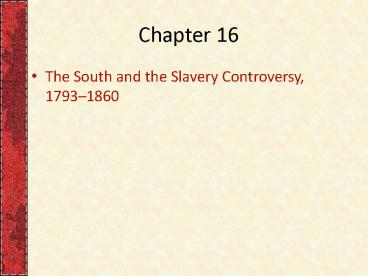The South and the Slavery Controversy, 1793 - PowerPoint PPT Presentation
1 / 29
Title: The South and the Slavery Controversy, 1793
1
Chapter 16
- The South and the Slavery Controversy, 17931860
2
I. Cotton Is King!
- Quick profits in cotton led an economic cycle of
buying more slaves and land to grow more cotton,
so they could buy more slaves and land. - Northern shippers made a lot of money from cotton
trade as well. - They loaded tons of cotton bales in Southern
ports and shipped them to Europe, where they
would purchase European goods to sell back in
America
3
- After 1840, the South produced more than half the
worlds cotton supply. - Britains most important industry was cotton
cloth, from which one-fifth of its population
drew its livelihood. - 75 of this supply came from the South.
- Southern leaders believed that if war ever broke
out between North and South, Northern warships
would cut off the Souths cotton exports. The
British in turn would be under such economic
strain that they would be forced to break the
Northern blockade, and the South would win.
4
II. The Planter Aristocracy
- Southern planter elite made the South more like
an oligarchy than a democracy. - Oligarchy is a government by the few.
- Largely due to this aristocracy the gap between
rich and poor continued to increase. - Southern women were also impacted by the
plantation system. - Relationships between mistress and slave ranged
from affectionate to atrocious.
5
p340
6
III. Slaves of the Slave System
- The economic structure of the South became
increasingly monopolistic. - Smaller farmers were forced to sell to the
bigger. - Financial instability with a one-crop economy,
many that bought more and more land and slaves
put too heavy invested in capital. - The south resented the fact that they were born
in Yankee-clothes, had to listen to
Yankee-manufacturing, and were laid to rest in
Yankee-coffins.
7
IV. The White Majority
- Only one-fourth of white southerners owned slaves
or belonged to a family that owned slaves. - The majority of Southern farmers had little
impact on the market (if any) and were mainly
subsistence farmers. They raised hogs and corn,
not cotton. - These whites without slaves had no direct
economic stake in preserving slavery, but they
were the loudest defenders of the slave system.
8
By 1860 whites who owned no slaves equaled
6,120,825
Figure 16-1 p341
9
V. Free Blacks Slaves Without Masters
- Free blacks in the South were looked at as a
third race. - Prohibited from working certain jobs and
testifying in court. - Vulnerable to being thrown back into slavery by
slave traders. - Free blacks were a constant reminder of what
could happen through emancipation and so they
were despised by the defenders of slavery.
10
- Free blacks in the North were also unpopular.
- Several states prohibited entrance.
- Prohibited from voting.
- Some barred from public schools.
- Northern blacks were despised by the Irish
immigrant who competed with them for the same
jobs. - Much of the northern agitation against the spread
of slavery grew out of racial prejudice, not
humanitarianism.
11
- Some have observed that white southerners (who
were raised by slave women,) liked the black as
an individual but despised the race. The white
northerner, on the other hand, professed to like
the race but disliked the individuals.
12
VI. Plantation Slavery
- After the slave imports were outlawed in 1808,
many were still smuggled into the South in the
years leading up to the Civil War. - Most of the increase in slave population came
from natural reproduction. Some women received
their freedom after having 10 kids for the
master. - Slave owners held around 2 billion of their
capital in slaves by 1860. This did lead many
slave owners to treat their slaves differently.
13
- Slaves were look at as investments worth around
1800 each. - Slave owners didnt want to risk death with their
investments. - They would rather an Irishmen who was getting
paid for the job die than their slave that was
already paid in full.
14
p345
15
p345
16
VII. Life Under the Lash
- Strong willed slaves were sent to breakers to
get put in line. - Savage beatings that left physical marks however
hurt resale values. They made it look as though
the slave was too strong willed. - A majority of blacks lived on large plantations
of twenty or more. Family life on these
plantations were mostly stable, however, on
smaller plantations forced separations of family
members was common.
17
p346
18
VIII. The Burdens of Bondage
- 90 of all slaves were illiterate.
- With no incentive, why should slaves work hard?
They slowed the work down to the bare minimum to
protest. - In 1831, Nat Turner led an uprising that killed
about 60 Virginians (mostly women and children)
before it was squashed.
19
- The Spanish slave ship Amistad (1839) was seized
by enslaved Africans off the coast of Cuba. They
attempted to sail back to Africa, but were driven
to shore on Long Island. After 2 years of
imprisonment and several trials, former president
John Q. Adams secured their freedom arguing
before the Supreme Court in 1841. The Africans
returned to Sierre Leone, in West Africa.
20
p349
21
IX. Early Abolitionism
- Some early abolitionist efforts were to
transplant blacks back to Africa. - The American Colonization Society (1817) was
established for this purpose. - In 1822 the Republic of Liberia was established
for former slaves. Its capital, Monrovia, was
named after President James Monroe. - Most slaves were native-born and had no desire to
leave their country.
22
p351
23
p352
24
p352
25
p354
26
Table 16-1 p355
27
p356
28
p356
29
p35































